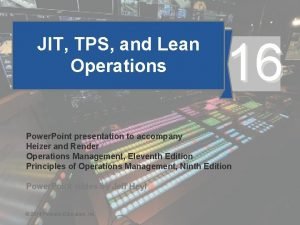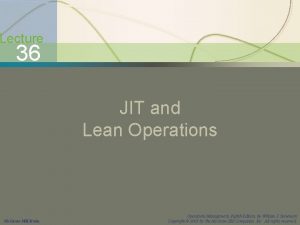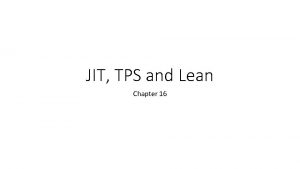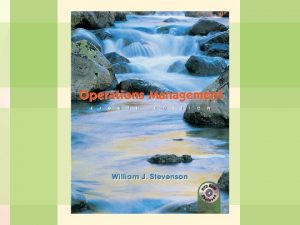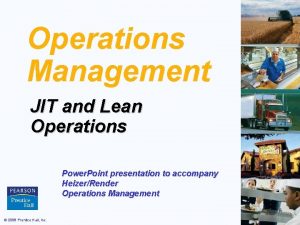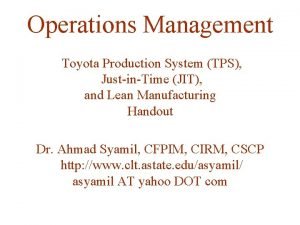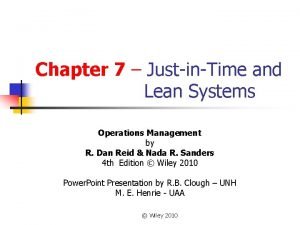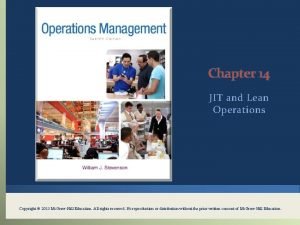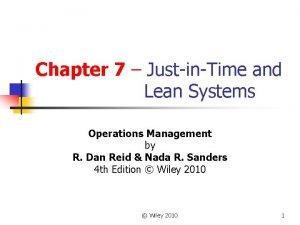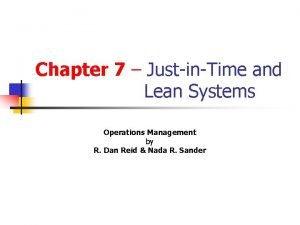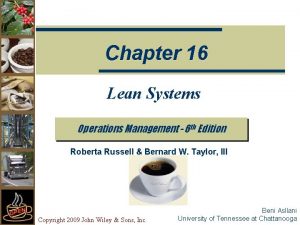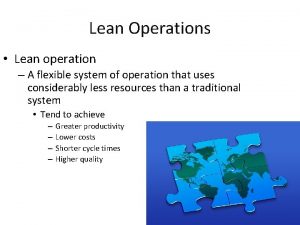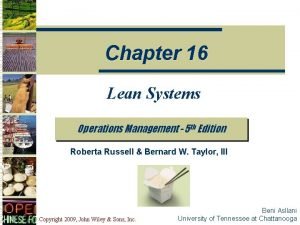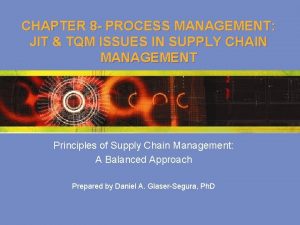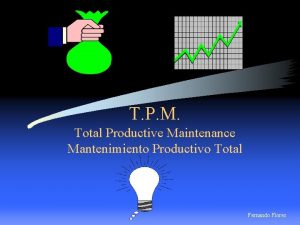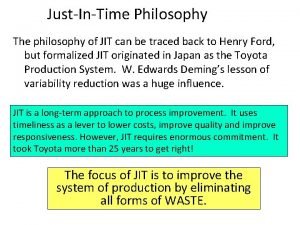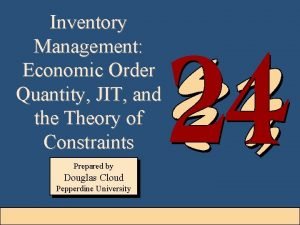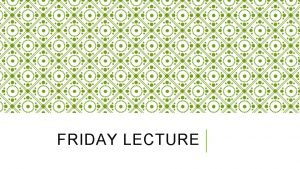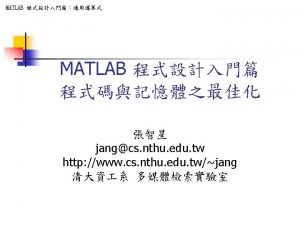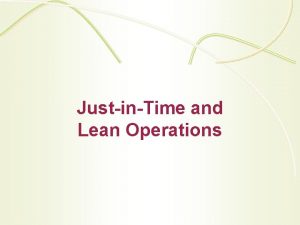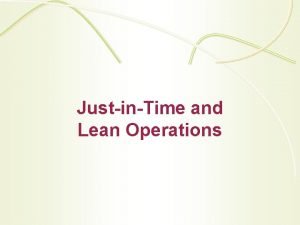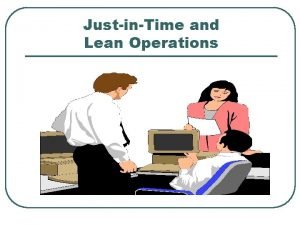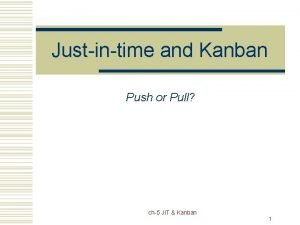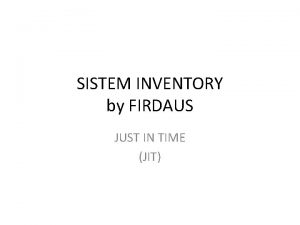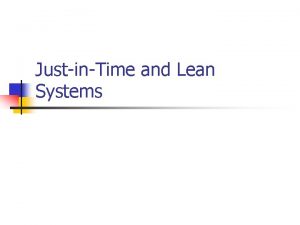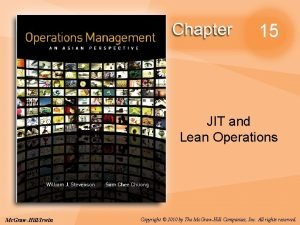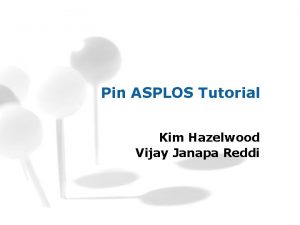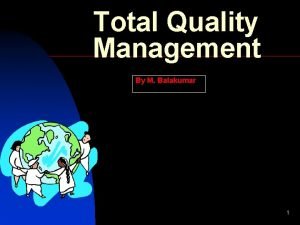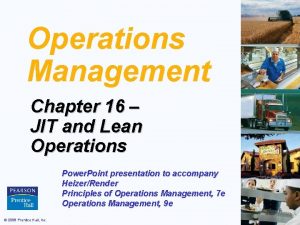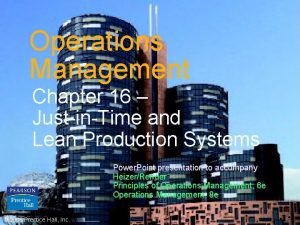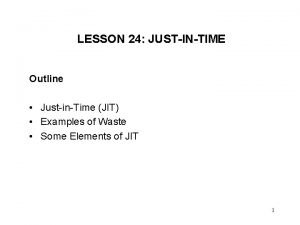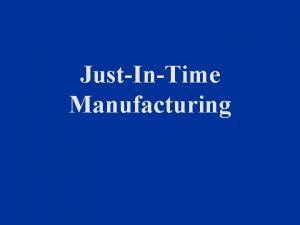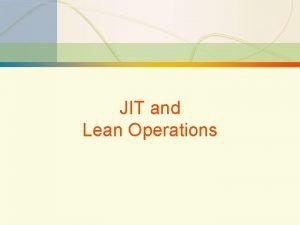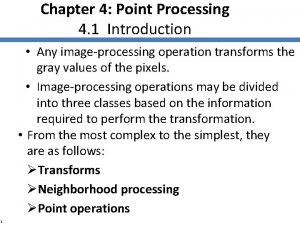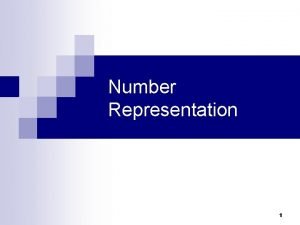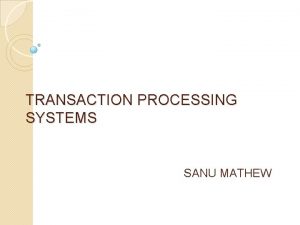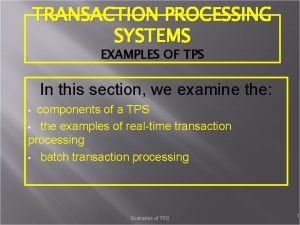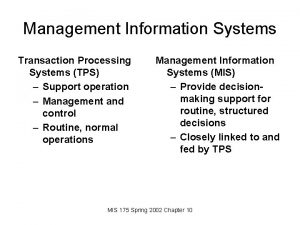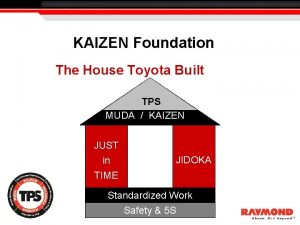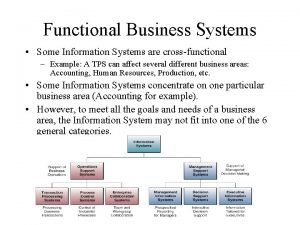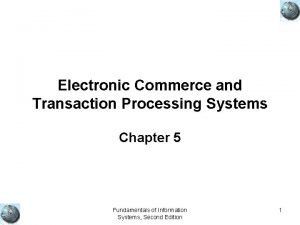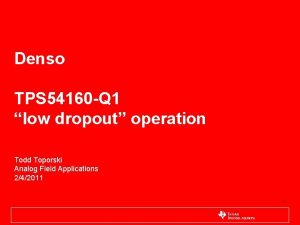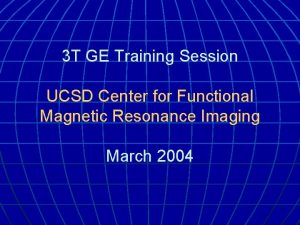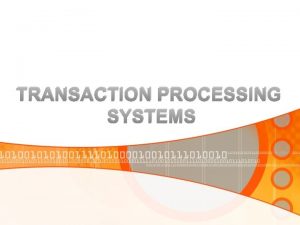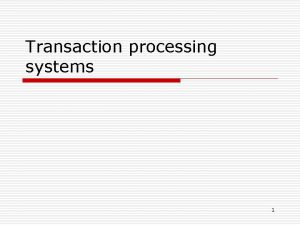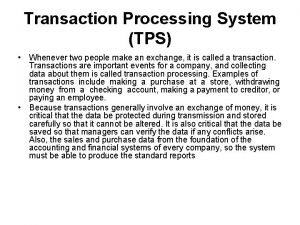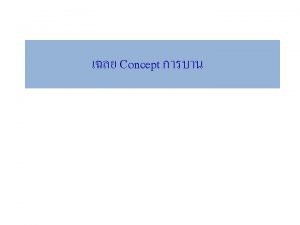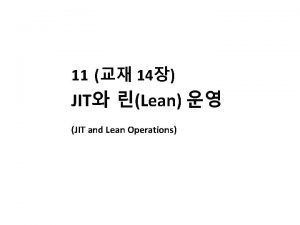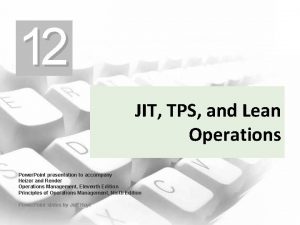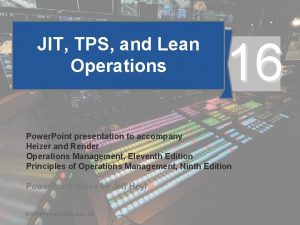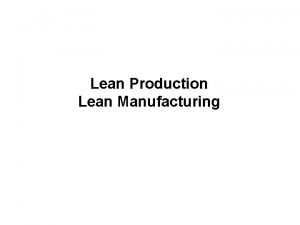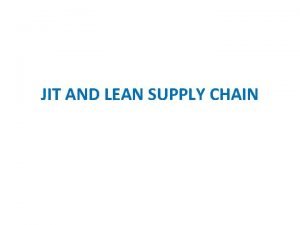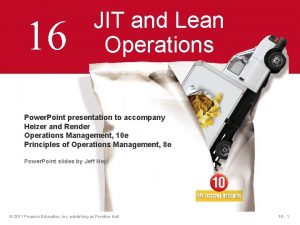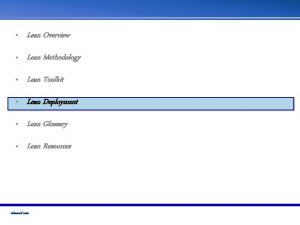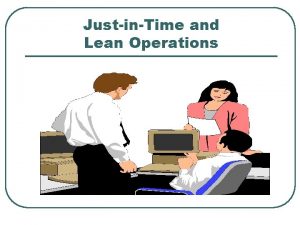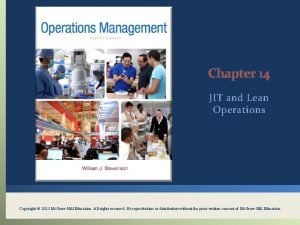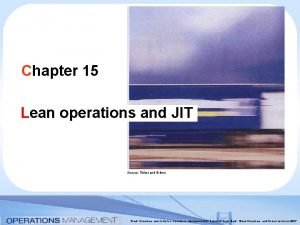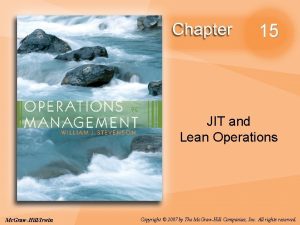JIT TPS and Lean Operations 16 Power Point































































- Slides: 63

JIT, TPS, and Lean Operations 16 Power. Point presentation to accompany Heizer and Render Operations Management, Eleventh Edition Principles of Operations Management, Ninth Edition Power. Point slides by Jeff Heyl © 2014 Pearson Education, Inc. © 2014 Pearson Education, 16 - 1

Outline ► ► ► Global Company Profile: Toyota Motor Corporation Just-in-Time, the Toyota Production System, and Lean Operations Just-in-Time (JIT) Toyota Production System (TPS) Lean Operations in Services © 2014 Pearson Education, Inc. 16 - 2

Learning Objectives When you complete this chapter you should be able to: 1. Define just-in-time, TPS, and lean operations 2. Define the seven wastes and the 5 Ss 3. Explain JIT partnerships 4. Determine optimal setup time © 2014 Pearson Education, Inc. 16 - 3

Learning Objectives When you complete this chapter you should be able to: 5. Define kanban 6. Compute the required number of kanbans 7. Explain the principles of the Toyota Production System © 2014 Pearson Education, Inc. 16 - 4

Toyota Motor Corporation ► ► Largest vehicle manufacturer in the world with annual sales of over 9 million vehicles Success due to two techniques, JIT and TPS Continual problem solving is central to JIT Eliminating excess inventory makes problems immediately evident © 2014 Pearson Education, Inc. © 2014 Pearson Education, 16 - 5

Toyota Motor Corporation ► ► ► Central to TPS is employee learning and a continuing effort to produce products under ideal conditions Respect for people is fundamental Small building but high levels of production Subassemblies are transferred to the assembly line on a JIT basis High quality and low assembly time per vehicle © 2014 Pearson Education, Inc. 16 - 6

TPS Elements © 2014 Pearson Education, Inc. 16 - 7

JIT/TPS/Lean Operations Good production systems require that managers address three issues that are pervasive and fundamental to operations management: eliminate waste, remove variability, and improve throughput © 2014 Pearson Education, Inc. 16 - 8

Just-In-Time, TPS, and Lean Operations ▶ JIT focuses on continuous forced problem solving ▶ TPS emphasizes continuous improvement, respect for people, and standard work practices in an assembly -line environment ▶ Lean operations emphasize understanding the customer © 2014 Pearson Education, Inc. 16 - 9

Eliminate Waste ▶ Waste is anything that does not add value from the customer point of view ▶ Storage, inspection, delay, waiting in queues, and defective products do not add value and are 100% waste © 2014 Pearson Education, Inc. 16 - 10

Ohno’s Seven Wastes ▶ ▶ ▶ ▶ Overproduction Queues Transportation Inventory Motion Overprocessing Defective products © 2014 Pearson Education, Inc. 16 - 11

Eliminate Waste ▶ Other resources such as energy, water, and air are often wasted ▶ Efficient, sustainable production minimizes inputs, reduces waste ▶ Traditional “housekeeping” has been expanded to the 5 Ss © 2014 Pearson Education, Inc. 16 - 12

The 5 Ss ▶ Sort/segregate – when in doubt, throw it out ▶ Simplify/straighten – methods analysis tools ▶ Shine/sweep – clean daily ▶ Standardize – remove variations from processes ▶ Sustain/self-discipline – review work and recognize progress © 2014 Pearson Education, Inc. 16 - 13

The 5 Ss ▶ Sort/segregate – when in doubt, throw it out ▶ Simplify/straighten – methods analysis tools Two additional Ss ▶ Shine/sweep – clean daily ► Safety – built in good practices ▶ Standardize – remove variations from ► Support/maintenance – reduce processes variability and unplanned downtime ▶ Sustain/self-discipline – review work and recognize progress © 2014 Pearson Education, Inc. 16 - 14

Remove Variability ▶ JIT systems require managers to reduce variability caused by both internal and external factors ▶ Variability is any deviation from the optimum process ▶ Inventory hides variability ▶ Less variability results in less waste © 2014 Pearson Education, Inc. 16 - 15

Sources of Variability ▶ Poor production processes resulting in improper quantities, late, or nonconforming units ▶ Unknown customer demands ▶ Incomplete or inaccurate drawings, specifications, or bills of material © 2014 Pearson Education, Inc. 16 - 16

Sources of Variability ▶ Poor production processes resulting in improper quantities, late, or nonconforming units ▶ Unknown customer demands ▶ Incomplete or inaccurate drawings, specifications, or bills of material inventory d n a in T I s J l o o t Both e tiv c e f f e e y r t i l a i b n a o i i r t a c v f o redu s e s u ca g n i y f i t n ide © 2014 Pearson Education, Inc. 16 - 17

Improve Throughput ▶ The time it takes to move an order from receipt to delivery ▶ The time between the arrival of raw materials and the shipping of the finished order is called manufacturing cycle time ▶ A pull system increases throughput © 2014 Pearson Education, Inc. 16 - 18

Improve Throughput ▶ By pulling material in small lots, inventory cushions are removed, exposing problems and emphasizing continual improvement ▶ Manufacturing cycle time is reduced ▶ Push systems dump orders on the downstream stations regardless of the need © 2014 Pearson Education, Inc. 16 - 19

Just-In-Time (JIT) ▶ Powerful strategy for improving operations ▶ Materials arrive where they are needed when they are needed ▶ Identifying problems and driving out waste reduces costs and variability and improves throughput ▶ Requires a meaningful buyer-supplier relationship © 2014 Pearson Education, Inc. 16 - 20

JIT and Competitive Advantage Figure 16. 1 © 2014 Pearson Education, Inc. 16 - 21

JIT and Competitive Advantage Figure 16. 1 © 2014 Pearson Education, Inc. 16 - 22

JIT Partnerships ▶ JIT partnerships exist when a supplier and purchaser work together to remove waste and drive down costs ▶ Four goals of JIT partnerships are: ▶ Removal of unnecessary activities ▶ Removal of in-plant inventory ▶ Removal of in-transit inventory ▶ Improved quality and reliability © 2014 Pearson Education, Inc. 16 - 23

JIT Partnerships Figure 16. 2 © 2014 Pearson Education, Inc. 16 - 24

Concerns of Suppliers ▶ Diversification – ties to only one customer increases risk ▶ Scheduling – don’t believe customers can create a smooth schedule ▶ Lead time – short lead times mean engineering or specification changes can create problems ▶ Quality – limited by capital budgets, processes, or technology ▶ Lot sizes – small lot sizes may transfer costs to suppliers © 2014 Pearson Education, Inc. 16 - 25

JIT Layout ▶ Reduce waste due to movement TABLE 16. 1 JIT LAYOUT TACTICS Build work cells for families of products Include a large number operations in a small area Minimize distance Design little space for inventory Improve employee communication Use poka-yoke devices Build flexible or movable equipment Cross-train workers to add flexibility © 2014 Pearson Education, Inc. 16 - 26

Distance Reduction ▶ Large lots and long production lines with single-purpose machinery are being replaced by smaller flexible cells ▶ Often U-shaped for shorter paths and improved communication ▶ Often using group technology concepts © 2014 Pearson Education, Inc. 16 - 27

Increased Flexibility ▶ Cells designed to be rearranged as volume or designs change ▶ Applicable in office environments as well as production settings ▶ Facilitates both product and process improvement © 2014 Pearson Education, Inc. 16 - 28

Impact on Employees ▶ Employees may be cross trained for flexibility and efficiency ▶ Improved communications facilitate the passing on of important information about the process ▶ With little or no inventory buffer, getting it right the first time is critical © 2014 Pearson Education, Inc. 16 - 29

Reduced Space and Inventory ▶ With reduced space, inventory must be in very small lots ▶ Units are always moving because there is no storage © 2014 Pearson Education, Inc. 16 - 30

JIT Inventory ▶ Inventory is at the minimum level necessary to keep operations running TABLE 16. 2 JIT INVENTORY TACTICS Use a pull system to move inventory Reduce lot sizes Develop just-in-time delivery systems with suppliers Deliver directly to point of use Perform to schedule Reduce setup time Use group technology © 2014 Pearson Education, Inc. 16 - 31

Reduce Variability Inventory level Process downtime Scrap Setup time Quality problems Late deliveries Figure 16. 3 © 2014 Pearson Education, Inc. 16 - 32

Reduce Variability Inventory level Process downtime Scrap Setup time Quality problems Late deliveries Figure 16. 3 © 2014 Pearson Education, Inc. 16 - 33

Reduce Variability Inventory level No scrap Setup time reduced Quality problems removed No late deliveries © 2014 Pearson Education, Inc. Process downtime removed Figure 16. 3 16 - 34

Reduce Inventory ▶ Reducing inventory uncovers the “rocks” ▶ Problems are exposed ▶ Ultimately there will Inventory be virtually no inventory and no problems ▶ Shingo says “Inventory is evil” © 2014 Pearson Education, Inc. 16 - 35

Reduce Lot Sizes Figure 16. 4 Q 1 When average order size = 200 average inventory is 100 Inventory 200 – Q 2 When average order size = 100 average inventory is 50 100 – Time © 2014 Pearson Education, Inc. 16 - 36

Reduce Lot Sizes ▶ Ideal situation is to have lot sizes of one pulled from one process to the next ▶ Often not feasible ▶ Can use EOQ analysis to calculate desired setup time ▶ Two key changes necessary ▶ Improve material handling ▶ Reduce setup time © 2014 Pearson Education, Inc. 16 - 37

Lot Size Example D d p Q H S = = = Annual demand = 400, 000 units Daily demand = 400, 000/250 = 1, 600 per day Daily production rate = 4, 000 units EOQ desired = 400 Holding cost = $20 per unit Setup cost (to be determined) Setup time = $2. 40/($30/hour) = 0. 08 hr = 4. 8 minutes © 2014 Pearson Education, Inc. 16 - 38

Reduce Setup Costs ▶ High setup costs encourage large lot sizes ▶ Reducing setup costs reduces lot size and reduces average inventory ▶ Setup time can be reduced through preparation prior to shutdown and changeover © 2014 Pearson Education, Inc. 16 - 39

Lower Setup Costs Figure 16. 5 Holding cost Cost Sum of ordering and holding costs T 1 Setup cost curve (S 2) T 2 S 1 Setup cost curve (S 1) Lot size © 2014 Pearson Education, Inc. 16 - 40

Reduce Setup Costs Figure 16. 6 90 min — Initial Setup Time Step 1 Separate setup into preparation and actual setup, doing as much as possible while the machine/process is operating (save 30 minutes) 60 min — Move material closer and improve material handling (save 20 minutes) Step 2 45 min — Standardize and improve tooling (save 15 minutes) Step 3 Step 4 Step 5 Step 6 © 2014 Pearson Education, Inc. Use one-touch system to eliminate adjustments (save 10 minutes) Training operators and standardizing work procedures (save 2 minutes) Repeat cycle until subminute setup is achieved 25 min — 13 min — — 16 - 41

JIT Scheduling ▶ Schedules must be communicated inside and outside the organization ▶ Level schedules ▶ Process frequent small batches ▶ Freezing the schedule helps stability ▶ Kanban ▶ Signals used in a pull system © 2014 Pearson Education, Inc. 16 - 42

JIT Scheduling ▶ Better scheduling improves performance TABLE 16. 3 JIT SCHEDULING TACTICS Communicate schedules to suppliers Make level schedules Freeze part of the schedule Perform to schedule Seek one-piece-make and one-piece move Eliminate waste Produce in small lots Use kanbans Make each operation produce a perfect part © 2014 Pearson Education, Inc. 16 - 43

Level Schedules ▶ Process frequent small batches rather than a few large batches ▶ Make and move small lots so the level schedule is economical ▶ Freezing the schedule closest to the due dates can improve performance © 2014 Pearson Education, Inc. 16 - 44

Scheduling Small Lots Figure 16. 7 JIT Level Material-Use Approach A A B B C B A A B B B C Large-Lot Approach A A A B B B B C Time © 2014 Pearson Education, Inc. 16 - 45 C

Kanban ▶ Kanban is the Japanese word for card ▶ The card is an authorization for the next container of material to be produced ▶ A sequence of kanbans pulls material through the process ▶ Many different sorts of signals are used, but the system is still called a kanban © 2014 Pearson Education, Inc. 16 - 46

Kanban Figure 16. 8 Signal marker hanging on post for part Z 405 shows that production should start for that part. The post is located so that workers in normal locations can easily see it. Signal marker on stack of boxes Part numbers mark location of specific part © 2014 Pearson Education, Inc. 16 - 47

Kanban Material/Parts Supplier Final assembly Finished goods Customer order Work cell Kanban © 2014 Pearson Education, Inc. Kanban 16 - 48

More Kanban ▶ When the producer and user are not in visual contact, a card can be used; otherwise, a light or flag or empty spot on the floor may be adequate ▶ Usually each card controls a specific quantity or parts although multiple card systems may be used if there are several components or if the lot size is different from the move size © 2014 Pearson Education, Inc. 16 - 49

More Kanban ▶ Kanban cards provide a direct control and limit on the amount of work-in-process between cells ▶ If there is an intermediate storage area, a two-card system can be used with one card circulating between the user and storage area and the other between the storage area and the producing area © 2014 Pearson Education, Inc. 16 - 50

The Number of Kanban Cards or Containers ▶ Need to know the lead time needed to produce a container of parts ▶ Need to know the amount of safety stock needed Demand during Safety lead time + stock Number of kanbans = (containers) Size of container © 2014 Pearson Education, Inc. 16 - 51

Number of Kanbans Example Daily demand Production lead time (Wait time + Material handling time + Processing time) Safety stock Container size = 500 cakes = 2 days = 1/2 day = 250 cakes Demand during lead time = 2 days x 500 cakes = 1, 000 Safety stock = ½ x Daily demand = 250 1, 000 + 250 Number of kanbans = =5 250 © 2014 Pearson Education, Inc. 16 - 52

Advantages of Kanban ▶ Small containers require tight schedules, smooth operations, little variability ▶ Shortages create an immediate impact ▶ Places emphasis on meeting schedules, reducing lead time and setups, and economic material handling ▶ Standardized containers reduce weight, disposal costs, wasted space, and labor © 2014 Pearson Education, Inc. 16 - 53

JIT Quality ▶ Strong relationship ▶ JIT cuts the cost of obtaining good quality because JIT exposes poor quality ▶ Because lead times are shorter, quality problems are exposed sooner ▶ Better quality means fewer buffers and allows simpler JIT systems to be used © 2014 Pearson Education, Inc. 16 - 54

JIT Quality Tactics TABLE 16. 4 JIT QUALITY TACTICS Use statistical process control Empower employees Build fail-safe methods (poka-yoke, checklists, etc. ) Expose poor quality with small lot JIT Provide immediate feedback © 2014 Pearson Education, Inc. 16 - 55

Toyota Production System ▶ Continuous improvement ▶ Build an organizational culture and value system that stresses improvement of all processes, kaizen ▶ Part of everyone’s job ▶ Respect for people ▶ People are treated as knowledge workers ▶ Engage mental and physical capabilities ▶ Empower employees © 2014 Pearson Education, Inc. 16 - 56

Toyota Production System ▶ Standard work practice ▶ Work shall be completely specified as to content, sequence, timing, and outcome ▶ Internal and external customer-supplier connection are direct ▶ Product and service flows must be simple and direct ▶ Any improvement must be made in accordance with the scientific method at the lowest possible level of the organization © 2014 Pearson Education, Inc. 16 - 57

Lean Operations ▶ Broader than JIT in that it is externally focused on the customer ▶ Starts with understanding what the customer wants ▶ Optimize the entire process from the customer’s perspective © 2014 Pearson Education, Inc. 16 - 58

Building a Lean Organization ▶ Transitioning to a lean system can be difficult ▶ Lean systems tend to have the following attributes ▶ Use JIT techniques ▶ Build systems that help employees produce perfect parts ▶ Reduce space requirements © 2014 Pearson Education, Inc. 16 - 59

Building a Lean Organization ▶ Lean systems tend to have the following attributes ▶ Develop partnerships with suppliers ▶ Educate suppliers ▶ Eliminate all but value-added activities ▶ Develop employees ▶ Make jobs challenging ▶ Build worker flexibility © 2014 Pearson Education, Inc. 16 - 60

Lean Sustainability ▶ Two sides of the same coin ▶ Maximize resource use and economic efficiency ▶ Focus on issues outside the immediate firm ▶ Driving out waste is the common ground © 2014 Pearson Education, Inc. 16 - 61

Lean Operations in Services ▶ The JIT techniques used in manufacturing are used in services ▶ Suppliers ▶ Layouts ▶ Inventory ▶ Scheduling © 2014 Pearson Education, Inc. 16 - 62

All rights reserved. No part of this publication may be reproduced, stored in a retrieval system, or transmitted, in any form or by any means, electronic, mechanical, photocopying, recording, or otherwise, without the prior written permission of the publisher. Printed in the United States of America. © 2014 Pearson Education, Inc. 16 - 63
 Jit tps and lean operations
Jit tps and lean operations Jit and lean manufacturing
Jit and lean manufacturing Jit layout tactics
Jit layout tactics Lean operations management
Lean operations management Jit operations management
Jit operations management Toyota production system operations management
Toyota production system operations management Lean systems operations management
Lean systems operations management The four building blocks of lean operations are
The four building blocks of lean operations are Lean systems operations management
Lean systems operations management Lean systems operations management
Lean systems operations management A production kanban authorizes a worker to:
A production kanban authorizes a worker to: The ultimate goal in a lean system is:
The ultimate goal in a lean system is: Lean systems operations management
Lean systems operations management Power triangle diagram
Power triangle diagram Power bi training powerpoint
Power bi training powerpoint Process management in tqm
Process management in tqm Point point power
Point point power Warp processing
Warp processing Estructura tpm
Estructura tpm Philosophy of jit
Philosophy of jit 15670t
15670t Jit philosophy
Jit philosophy Vectorizing matlab
Vectorizing matlab Characteristics of just-in-time partnerships do not include
Characteristics of just-in-time partnerships do not include Formula kanban
Formula kanban Toyota jit
Toyota jit Kanban push pull
Kanban push pull Jit manufacturing emphasizes
Jit manufacturing emphasizes Kelemahan jit
Kelemahan jit Philosophy of jit
Philosophy of jit Jit building blocks
Jit building blocks Kim hazelwood
Kim hazelwood Jit balakumar
Jit balakumar Jit layout tactics
Jit layout tactics Jit layout tactics
Jit layout tactics 24 just in time
24 just in time Just-in-time production
Just-in-time production Jit inventory
Jit inventory Mis and tps
Mis and tps Disadvantages of hub and spoke system
Disadvantages of hub and spoke system Floating point operations per seconds
Floating point operations per seconds Fractal image
Fractal image Point processing operations
Point processing operations Floating point
Floating point Point processing operations
Point processing operations Tps payroll system
Tps payroll system Transaction processing system example
Transaction processing system example Transaction processing system (tps) adalah
Transaction processing system (tps) adalah A tps supports
A tps supports What is an mis
What is an mis Tps kaizen
Tps kaizen Functional business system in mis
Functional business system in mis Finger tps
Finger tps Tps it online commerce
Tps it online commerce Denso tps
Denso tps Ucsd tps
Ucsd tps Www.tps.gov login
Www.tps.gov login Transaction processing system
Transaction processing system Features of transaction processing system
Features of transaction processing system Tps transaction processing system
Tps transaction processing system Tps alert
Tps alert Objectives of transaction processing system
Objectives of transaction processing system Types of tps
Types of tps Er diagram for product sales
Er diagram for product sales
